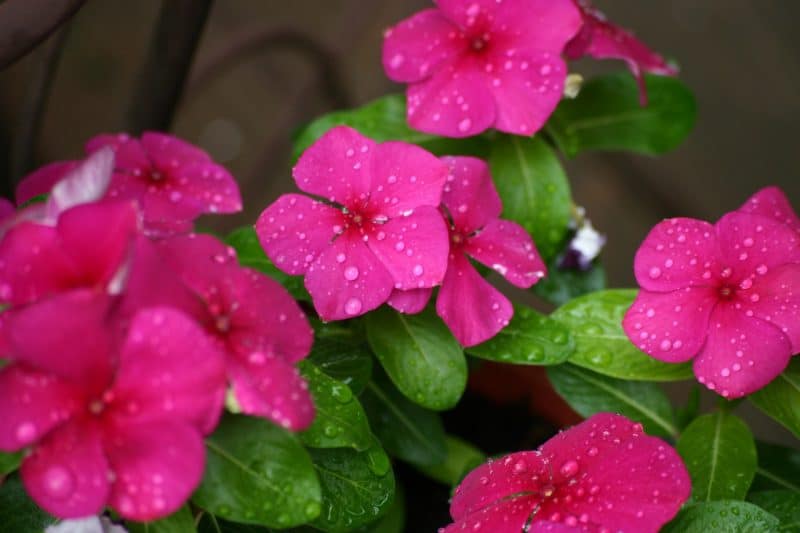You can quickly learn how to plant vinca seeds in two simple steps. It’s not surprising that more and more gardeners are getting interested in this evergreen, so you must learn various propagation methods. And if you have seeds, don’t feel intimidated because it is relatively easy to start them this way.
Best for temperate regions, consider starting vinca seeds in the greenhouse to guarantee germination. Remember that sowing seeds will only be tricky if the environment is fluctuating. If you mimic the natural growing conditions of vinca using a greenhouse, you should successfully grow healthy plants.

How To Grow Vinca Seeds
Step #1. Germination
The first step in planting vinca seeds is germinating the seeds themselves. It’s advantageous to sprout the seeds indoors and then transplant the seedlings outside once the climate is more stable. This way, you can ensure that the seeds will germinate and the seedlings are vigorous enough for outdoor transplanting in spring.
You can use any high-quality seedling compost and sow the seeds on the surface of a nursery flat. Allocate a space of two inches in between the seeds and press them into the medium before covering with compost. Remember that moisture is essential to encourage sprouting, so mist the medium and maintain moisture until the seeds germinate.
You can also create a moist, dark, and humid environment by covering the nursery flat with a black plastic bag. However, you must replace this cover after each watering as well. And in addition to this dark environment, you can place the seeds on a heat mat before setting them in the greenhouse.
Step #2. Maintenance
You can expect the seeds to germinate within two weeks. Given that the conditions are right, they can even develop as quickly as one week. Once your seeds sprout, make sure to remove the cover and lessen the frequency and amount of water you provide.
You don’t want to damage the seedlings due to overwatering accidentally. You can also use the grow lights in the greenhouse to encourage further development. A week after germination, fertilize with a diluted feed that is low in phosphorus to boost your vinca plants as well.
After some time, thin the seedlings in the flat, so only the strongest ones remain. Transplant them into individual pots with well-draining soil after they grow healthy mature leaves. Don’t forget to gradually acclimate your vinca plants before bringing them outdoors, somewhere bright with diffused sunlight and daytime temperatures around 65°F.
How To Transplant Vinca
Knowing how to transplant vinca is useful not just for propagation but also for maintenance. However, remember to only transplant vincas when the weather is cool to avoid stressing them out. It’s ideal to do so early in spring or fall.
Some gardeners also cut back some foliage to make it easier to see the roots. Then, dig around the plant to make it easier to lift the vinca off the ground. Make sure to transplant vinca to keep the roots from drying out immediately.
Choose an area with partial to full shade and plant in fertile and well-draining soil. Stabilize your plants by packing the ground around the roots. Lastly, maintain soil moisture and fertilizer to boost the growth of the plants.
What Is The Difference Between Annual Vinca And Perennial Vinca?
Understandably, it cannot be very clear to know the difference between annual and perennial vinca. However, you must know how to grow these plants depending on their ideal conditions and requirements. For starters, annual vinca makes excellent bedding plants that will thrive in full sun.
On the other hand, perennial vincas are also spreading plants, but you can classify them into Vinca minor and Vinca major. The former does best in partial to full shade, while the latter usually die during extreme winter. More so, Vinca major has a mounding habit compared to Vinca minor that only grows up to 6 inches.
Growing annual vinca vs perennial vinca
As mentioned earlier, annual vincas are best in full sun, especially when you want optimal flowering. Once established, you don’t need to worry about drought. They are also relatively low-maintenance that you don’t need to do any deadheading.
Perennial vincas, on the other hand, should be in partial to full shade. Vinca minor and Vinca major have similar condition requirements as well, so you can grow them under the same practices. However, it’s best to trim them after winter to remove the damaged leaves.
Conclusion
Gone are the days where you should be intimidated in starting plants via seeds. If you’re particularly interested in vinca, it only takes two steps to master how to plant vinca seeds. You can use a greenhouse to your advantage and successfully germinate vigorous seedlings for transplanting.
After all, germination is perhaps the most crucial stage when planting any plant seeds. When the conditions are not fluctuating, and you provide a moist and warm environment, you can easily encourage vinca seeds to sprout. Then, thin the seedlings and transplant them in individual pots with well-draining soil.
Wait for the weather to warm up in spring and acclimate your vinca plants for outdoor transplanting. Choose a bright site with diffused sunlight, and you should help the young vinca plants to develop quickly. Finally, maintain soil moisture and always monitor your plants.
